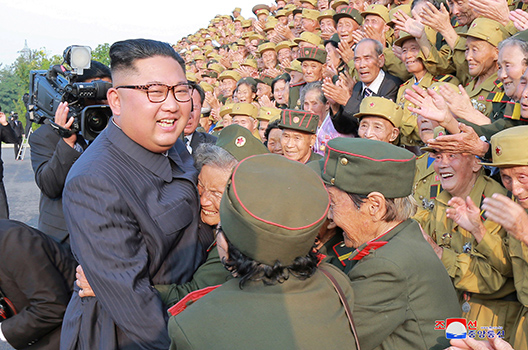 North Korea was caught again. The Washington Post reported on July 30 that the Democratic People’s Republic of Korea (DPRK) is still constructing long-range missiles capable of reaching the US homeland. This may not be a technical violation of Pyongyang’s agreements with the United States, but it is significant.
North Korea was caught again. The Washington Post reported on July 30 that the Democratic People’s Republic of Korea (DPRK) is still constructing long-range missiles capable of reaching the US homeland. This may not be a technical violation of Pyongyang’s agreements with the United States, but it is significant.
North Korea has been riding high since the Singapore summit; Kim Jong Un is the first North Korean leader to hold court with a sitting US president. Kim had to put less on the table than all past frameworks. He then scored a series of meetings with Chinese leader Xi Jingping and received Russian Foreign Minister Lavrov in Pyongyang.
The reports on missile construction show that Kim believes he has the latitude to bolster his arsenal with limited consequences. It underscores the view that the Singapore summit greatly benefited the North, while harming chances to actually solve this long-standing conundrum. The idea that the North has been boxed in or made a fateful decision to forgo nuclear weapons looks less and less likely.
The Washington Post reported that “work is underway on at least one and possibly two liquid-fueled intercontinental ballistic missiles (ICBMs) at a large research facility in Sanumdong, on the outskirts of Pyongyang.” This news comes on the heels of revelations – just after the Singapore summit – that the DPRK is ramping up production of highly enriched uranium, according to US intelligence agencies.
These developments, along with China and Russia’s decision to block new sanctions against the North for selling coal and other goods abroad, in contravention to United Nations resolutions, shows Kim was neither seduced by President Trump nor feels particular pressure to make a choice between guns or butter.
Yet, the picture is not all good for the DPRK. North Korea’s economy contracted 3.5% this year, according to South Korean government estimates. Economic growth is key to Kim Jong’s Un strategic plan for long-term regime survival. Soon after assuming power, Kim moved away the doctrine of songun, or “military first,” pushed by his father, and quickly adopted a new strategy of byongjin, simultaneously pursuing nuclear weapons and economic growth. Kim has created expectations for growth and actually is under pressure to deliver. Sanctions harm Kim and the North in powerful ways, so South Korea and the United States are not without leverage.
But exercising this leverage requires patience and foresight. It means appearing less anxious for grand statements and grateful for diversionary gestures. The United States must not waiver on the primary demand of complete, verifiable, irreversible disarmament (CVID) of North Korea’s nuclear weapons and long-range missile programs. This is the prime objective even if there is no clear path for getting there any time soon.
Despite – or perhaps because of – the flowery statements and dynamics between the Chairman and President Trump, there really are no new indicators suggesting North Korea is any more prepared to negotiate away its strategic weapons that it has been in the past. The Singapore statement is a significant walk back of mutually-agreed-upon steps made numerous times since the 1990s. By settling on the weak language of Singapore, we have put the burden on our negotiators to fight for regaining essential concepts like CVID. North Korea is masterful at gaining concessions over and over again for the same thing, so we can expect lengthy rounds of talks leading to some reward for (hopefully) getting back to where we were before Singapore.
So, how should the United States respond to these latest reports? Should we walk away from the table until North Korea’s enrichment and missile production actions stop? Should we seek to layer on new punishments? Should we press South Korea to freeze bilateral peace talks and accompanying confidence-building measures with the North? Can we do something to increase pressure on China? Should we declare joint exercises with the South back since North Korea is acting in a dangerous and hostile way?
The answer at the strategic level is to demonstrate willingness to walk away from talks. This will likely trigger another wave of angry and destabilizing actions by the North, to include pointed toward the South and visible testing of strategic programs, but this is the rhythm of negotiating with the DPRK. Ignoring the continued construction of missiles will only reinforce to the North that it has a significant upper hand vis-à-vis the United States and that Washington is more focused on superficial visuals than substantive progress.
The Trump administration seems to believe it alone knows how to negotiate “good” deals for the United States, and that history is no guide to seeing pitfalls and opportunities. But of course, this is not true. Many of us have read the playbook and participated in the dance with the North over the decades, and what we are witnessing today is standard, predictable practice. We know the playbook, and we know how much leverage we’ve lost this year by emphasizing pomp over substance. The Trump administration needs to better appreciate the historical record before it gives up even more.
Todd Rosenblum is a nonresident senior fellow at the Atlantic Council’s Scowcroft Center for Strategy and Security. You can follow him on Twitter @ToddRosenblum1.
Image: North Korean leader Kim Jong Un meets participants of the 5th National Conference of War Veterans in this undated photo released by North Korea's Korean Central News Agency (KCNA) on July 27, 2018. (KCNA via REUTERS)
